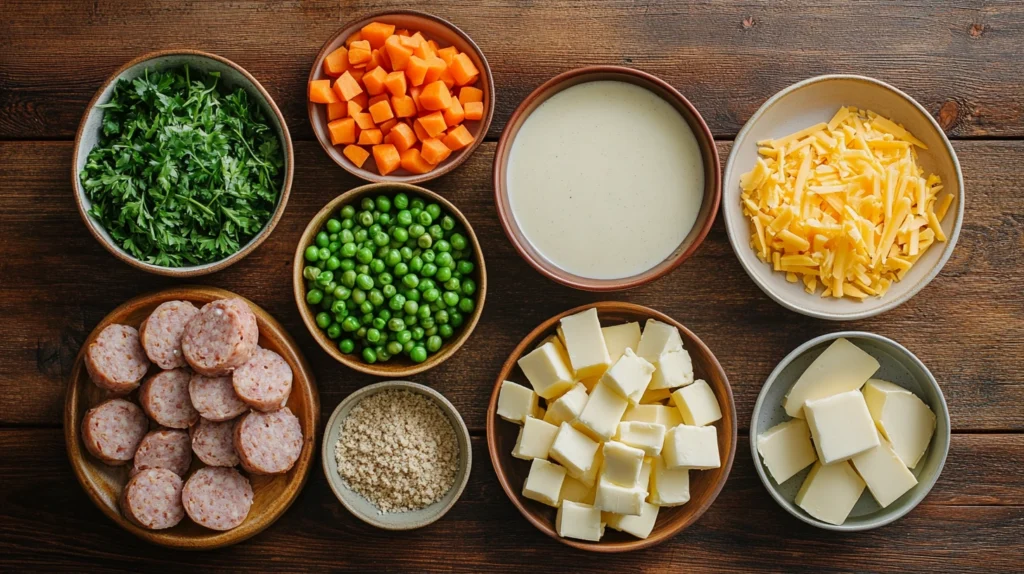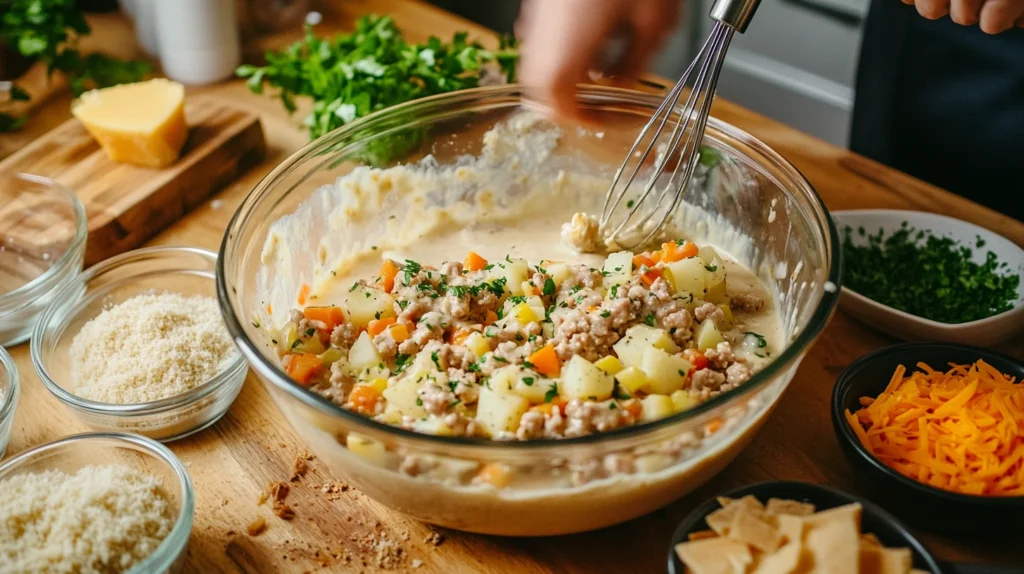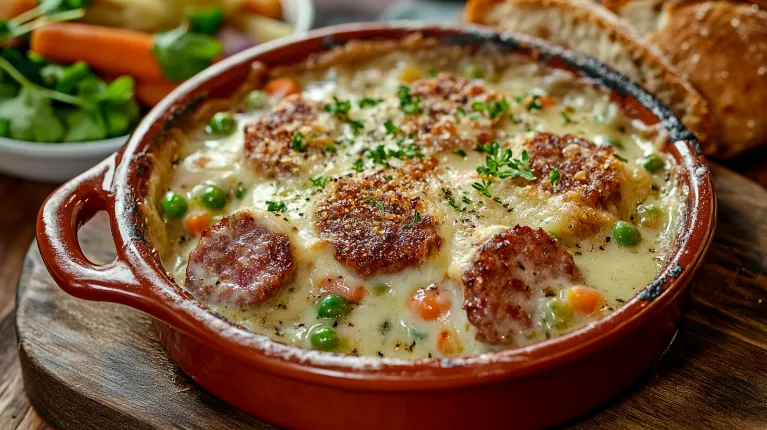Introduction
Casseroles have long been the ultimate comfort food, and this Canned White Gravy Casserole with Vegetables and Sausage is no exception. By combining the creamy goodness of canned white gravy with hearty vegetables and savory sausage, this dish offers a delightful mix of flavor and convenience. Whether you’re looking for a meal to serve on busy weeknights or a comforting option for lazy weekends, it requires minimal prep while delivering maximum satisfaction.
Moreover, this recipe is incredibly versatile. For instance, you can easily swap out vegetables or sausage based on what you have at home, making it a great way to clear out your fridge. In addition, using canned white gravy not only saves time but also guarantees consistent results every time you prepare it.
Furthermore, casseroles like this are ideal for meal prepping, as they store and reheat beautifully. Thus, whether you’re feeding a crowd or planning meals ahead of a busy week, this dish fits the bill perfectly. For more tips on the benefits of meal prepping with casseroles, check out this helpful guide.
Finally, with its rich, creamy texture and savory flavors, this casserole is sure to become a family favorite. Let’s dive into the simple ingredients and step-by-step instructions that will make this comforting dish a staple in your home.
Ingredients and Required Equipment
Ingredients
- Canned White Gravy: 2 cups. Substitution: Use homemade white gravy or cream of mushroom soup.
- Sausage: 1 lb, cooked and sliced (e.g., smoked, Italian, or breakfast sausage). Alternative: Use plant-based sausage for a vegetarian option.
- Vegetables: 1 cup each of carrots, green beans, and peas. Alternative: Frozen mixed vegetables work well.
- Potatoes: 2 cups, cubed and pre-cooked. Substitution: Sweet potatoes for a unique twist.
- Cheese: 1 cup shredded cheddar (optional).
- Seasonings: ½ tsp each of garlic powder, black pepper, and paprika.
- Breadcrumbs: ¼ cup for a crispy topping (optional).
Equipment
- Baking Dish: A 9×13-inch casserole dish is ideal.
- Learn how to choose the best casserole dish.
- Skillet: For browning sausage.
- Mixing Bowls: To combine ingredients.
- Cutting Board and Knife: For prepping vegetables.
Having these ingredients and tools on hand ensures a smooth cooking process and consistent results every time.

Step-by-Step Guide for Making Canned White Gravy Casserole
Casseroles have long been the ultimate comfort food, and this Canned White Gravy Casserole with Vegetables and Sausage is no exception. By combining the creamy goodness of canned white gravy with hearty vegetables and savory sausage, this dish offers a delightful mix of flavor and convenience. Whether you’re looking for a meal to serve on busy weeknights or a comforting option for lazy weekends, it requires minimal prep while delivering maximum satisfaction.
Moreover, this recipe is incredibly versatile. For instance, you can easily swap out vegetables or sausage based on what you have at home, making it a great way to clear out your fridge. In addition, using canned white gravy not only saves time but also guarantees consistent results every time you prepare it.
Furthermore, casseroles like this are ideal for meal prepping, as they store and reheat beautifully. Thus, whether you’re feeding a crowd or planning meals ahead of a busy week, this dish fits the bill perfectly. For more tips on the benefits of meal prepping with casseroles, check out this helpful guide.
Finally, with its rich, creamy texture and savory flavors, this casserole is sure to become a family favorite. Let’s dive into the simple ingredients and step-by-step instructions that will make this comforting dish a staple in your home.

Tips and Tricks for Perfecting Canned White Gravy in Casserole
Creating a flawless casserole requires attention to detail and a few expert tricks to handle common challenges. Here are some tips to make your dish shine.
1. Preventing Gravy Separation
Canned white gravy can separate during baking if exposed to prolonged high heat. To avoid this, mix the gravy with the other ingredients thoroughly to distribute heat evenly. However, if you notice the gravy thickening too much, adding a splash of milk or broth before baking helps maintain its creamy consistency.
2. Balancing Vegetable Moisture
Vegetables like carrots, green beans, or frozen options can release water during baking, making the casserole watery. To counteract this, blanch fresh vegetables beforehand to reduce their moisture content. On the other hand, if using frozen vegetables, pat them dry with a paper towel to remove excess ice.
3. Ensuring a Crispy Topping
A crispy, golden topping elevates the dish’s appeal. For best results, sprinkle breadcrumbs or shredded cheese on top before baking. If you want extra crunch, lightly toast breadcrumbs in butter before adding them to the casserole.
4. Enhancing Flavor
While canned gravy is convenient, it may lack depth. Adding Worcestershire sauce, Dijon mustard, or a pinch of nutmeg can enhance its flavor. Don’t forget to taste-test your mixture before baking to adjust seasoning levels.
By keeping these tips in mind, your casserole will have a perfect balance of creamy texture, vibrant vegetables, and rich flavor.
Serving and Garnishing Canned White Gravy in Casserole
Presentation can turn a simple casserole into an eye-catching centerpiece. Follow these serving and garnishing tips for added flair.
1. Serving Suggestions
Casseroles pair wonderfully with a side of crusty bread, garlic knots, or a fresh green salad. For a more filling option, serve alongside mashed potatoes or rice. A refreshing beverage like iced tea or a light white wine complements the dish beautifully.
2. Creative Garnishing Ideas
Likewise, garnishing adds a pop of color and freshness. Sprinkle chopped parsley, thyme, or chives over the casserole before serving. A light drizzle of melted butter over breadcrumbs can also enhance the visual and flavor appeal.
3. Plating Tips
For an elegant presentation, serve the casserole in individual ramekins. To summarize, use a large serving spoon to plate portions neatly and top each with a garnish of fresh herbs or a dash of paprika.
By pairing and presenting thoughtfully, you’ll elevate this comforting casserole to a gourmet dining experience.

Common Mistakes to Avoid When Preparing Canned White Gravy in Casserole
Even with simple recipes, small mistakes can affect the outcome. Avoid these pitfalls for a consistently delicious casserole.
1. Soggy Vegetables
Vegetables that aren’t prepped properly can make the dish watery. Always blanch fresh vegetables and pat them dry, or use pre-cooked options. Frozen vegetables should be thawed and dried to prevent excess moisture during baking.
2. Overly Thick Gravy
If the gravy thickens too much, it can result in a dry casserole. To fix this, thin the gravy with milk or broth before combining it with other ingredients. Avoid baking the casserole for too long, as it can over-reduce the gravy.
3. Uneven Cooking
Crowding the baking dish or uneven layering can lead to unevenly cooked ingredients. Spread the mixture evenly in the dish, ensuring each layer is well-integrated. Using a properly preheated oven also helps with even baking.
4. Bland Flavor
While canned gravy is convenient, it often needs additional seasoning. Taste your mixture before baking and adjust with garlic powder, paprika, or even a splash of hot sauce for added depth.
For more solutions to common casserole issues, check out this guide on fixing casserole mistakes.
By addressing these potential problems, your casserole will come out perfectly creamy, flavorful, and satisfying every time.
FAQ Section for Canned White Gravy in Casserole with Vegetables and Sausage
1. How can I make canned white gravy taste better?
Improving canned white gravy is simple and can make your casserole even more delicious. For example, adding a splash of milk or cream makes the gravy richer and smoother. Additionally, spices like garlic powder, black pepper, or paprika can bring out the flavor. You might also try stirring in a teaspoon of Dijon mustard or Worcestershire sauce for a bolder, savory taste.
2. What is the difference between white gravy and sausage gravy?
The key difference is that white gravy is a basic creamy sauce made from milk, butter, and flour, while sausage gravy includes cooked sausage for extra flavor and heartiness. Thus, sausage gravy is often more filling and has added spices like sage or cayenne pepper. To make sausage gravy, simply add browned sausage to white gravy, which is easy and versatile.
3. Why is white gravy called sawmill gravy?
White gravy is often called “sawmill gravy” because it was commonly served in lumber camps. Consequently, it became a staple due to its simplicity and affordability, using basic ingredients like flour and milk. Workers relied on this hearty sauce to stay full throughout the day, making it a lasting favorite in many homes today.
These answers provide useful insights to help you make your casserole even better!
Conclusion for Canned White Gravy in Casserole with Vegetables and Sausage
In conclusion, the Canned White Gravy Casserole with Vegetables and Sausage is a simple yet satisfying dish that brings comfort and flavor to the dinner table. Its creamy gravy, savory sausage, and colorful vegetables create a delicious combination that is sure to please everyone. Moreover, this recipe is easy to customize, making it perfect for both experienced cooks and beginners.
All things considered, this casserole’s versatility is what makes it so appealing. You can replace sausage with chicken, ground beef, or plant-based options. Likewise, adding your favorite vegetables or extra spices allows you to make it your own. For a complete meal, consider pairing it with sides like Green Bean Casserole with Cream of Chicken or a simple side salad.
Finally, we encourage you to try this recipe and share your own twists. Did you add a crispy breadcrumb topping or use spicy sausage for extra heat? Let us know in the comments! Recipes like this aren’t just about food—they’re about creating memories with loved ones.
So, grab your ingredients and start baking this delicious casserole today. With its rich flavor and comforting texture, it’s sure to become a favorite in your kitchen!




